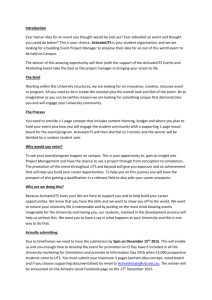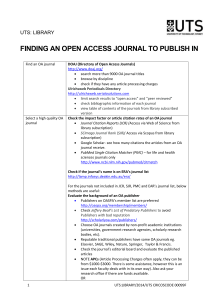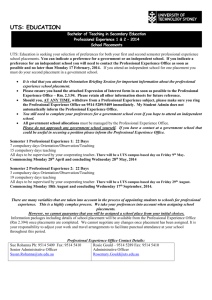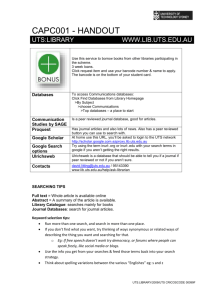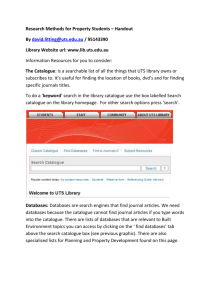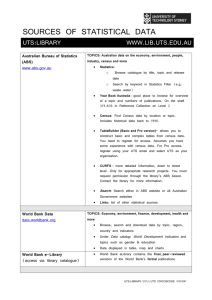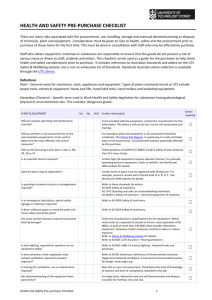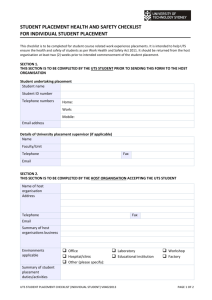vcltsmallsmallgrantsguide_2014_final
advertisement
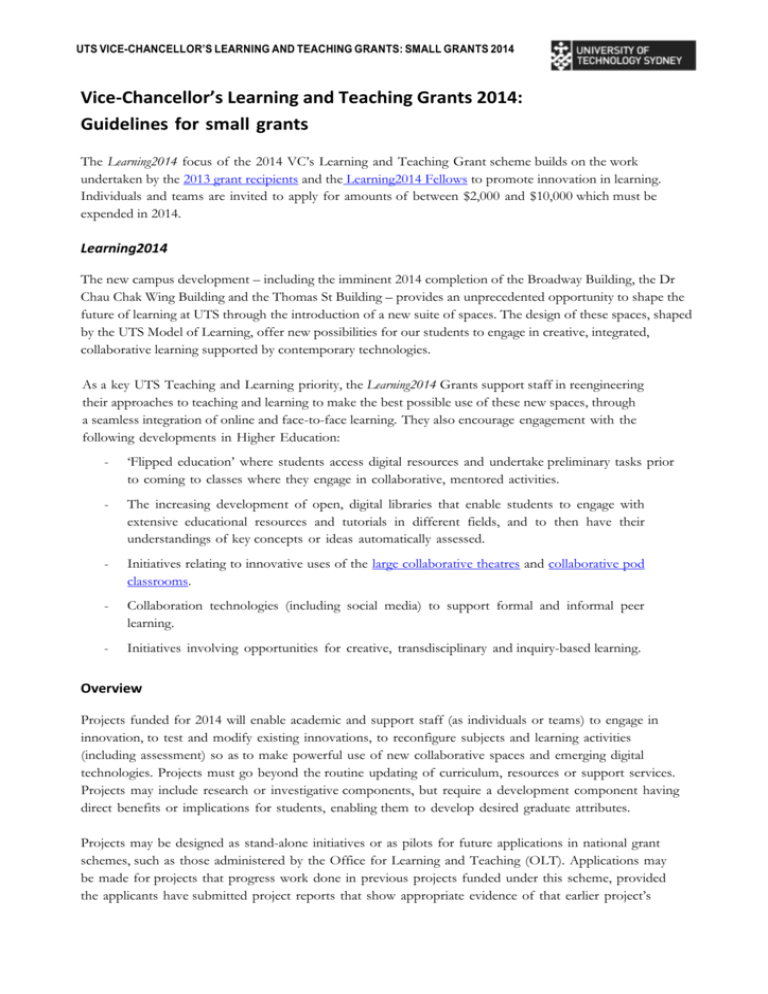
UTS VICE-CHANCELLOR’S LEARNING AND TEACHING GRANTS: SMALL GRANTS 2014 Vice-Chancellor’s Learning and Teaching Grants 2014: Guidelines for small grants The Learning2014 focus of the 2014 VC’s Learning and Teaching Grant scheme builds on the work undertaken by the 2013 grant recipients and the Learning2014 Fellows to promote innovation in learning. Individuals and teams are invited to apply for amounts of between $2,000 and $10,000 which must be expended in 2014. Learning2014 The new campus development – including the imminent 2014 completion of the Broadway Building, the Dr Chau Chak Wing Building and the Thomas St Building – provides an unprecedented opportunity to shape the future of learning at UTS through the introduction of a new suite of spaces. The design of these spaces, shaped by the UTS Model of Learning, offer new possibilities for our students to engage in creative, integrated, collaborative learning supported by contemporary technologies. As a key UTS Teaching and Learning priority, the Learning2014 Grants support staff in reengineering their approaches to teaching and learning to make the best possible use of these new spaces, through a seamless integration of online and face-to-face learning. They also encourage engagement with the following developments in Higher Education: - ‘Flipped education’ where students access digital resources and undertake preliminary tasks prior to coming to classes where they engage in collaborative, mentored activities. - The increasing development of open, digital libraries that enable students to engage with extensive educational resources and tutorials in different fields, and to then have their understandings of key concepts or ideas automatically assessed. - Initiatives relating to innovative uses of the large collaborative theatres and collaborative pod classrooms. - Collaboration technologies (including social media) to support formal and informal peer learning. - Initiatives involving opportunities for creative, transdisciplinary and inquiry-based learning. Overview Projects funded for 2014 will enable academic and support staff (as individuals or teams) to engage in innovation, to test and modify existing innovations, to reconfigure subjects and learning activities (including assessment) so as to make powerful use of new collaborative spaces and emerging digital technologies. Projects must go beyond the routine updating of curriculum, resources or support services. Projects may include research or investigative components, but require a development component having direct benefits or implications for students, enabling them to develop desired graduate attributes. Projects may be designed as stand-alone initiatives or as pilots for future applications in national grant schemes, such as those administered by the Office for Learning and Teaching (OLT). Applications may be made for projects that progress work done in previous projects funded under this scheme, provided the applicants have submitted project reports that show appropriate evidence of that earlier project’s UTS VICE-CHANCELLOR’S LEARNING AND TEACHING GRANTS: SMALL GRANTS 2014 success. Projects should demonstrate they are consistent with the UTS Strategic Plan 2009-2018, the UTS Model of Learning and the UTS Graduate Attributes Project. Successful grant applicants will be required to contribute to the new Learning2014 website. Applicants are encouraged to become familiar with the website’s community building approach. Social media and other online strategies will be an integral aspect of how successful grant holders engage academics, support staff and students as well as enable networks and collaboration across UTS. A final project report (due February 2015) should outline project activities, developments, outcomes and also a statement of expenditure against the project budget. Application requirements and guide Any application must be submitted on the project application form, be no longer than 4 pages and include 4 components: 1. Project Summary Project title: A good title would accurately communicate the Project’s overall intention, suggesting its significance. Summary of Project In no more than 100 words of plain language, summarise aims, significance and anticipated outcomes of the proposed Project. The summary should be written for a general audience, as (if successful) the summary will appear on the UTS’s website. Use “The project will … “ rather than “I will” “We will” etc in the summary. Keywords Provide 5-8 key words that indicate this Project’s focus. Project applicant/team leader: Name: Position: Contact email: Contact phone no: Faculty/Unit: School/Department (if applicable): UTS VICE-CHANCELLOR’S LEARNING AND TEACHING GRANTS: SMALL GRANTS 2014 2. Project Description Aims and Background: What does this Project set out to achieve? What is the particular UTS context of this Project’s aspirations? For example, student demographics, relationships with industry, social justice aspirations, engagement with contemporary challenges and research developments in this discipline. How does it relate to other disciplinary developments in this Project’s educational field? Does this Project build on earlier work and if so, how? Significance and rationale: Why is it important to undertake this Project? Are there underlying questions that this Project could shed light on, enabling new insights? Please state the questions and elaborate where relevant. How does this Project meet UTS strategic aims and enact the UTS Model of Learning? How does it relate to the intended graduate attributes? What are the anticipated outcomes of this Project? How will this Project result in benefits for UTS students? Approaches to conducting the Project: How will this Project be conducted? What activities and initiatives will be undertaken? How does this Project engage with Learning2014? Why were these particular approaches to conducting the Project chosen? What methods will be used to gauge the Project’s success? If underlying questions were identified (in the previous ‘Significance and rationale’ s ection), what are initial ideas for how they could be investigated? A Project plan and proposed timelines must be included. Communicating progress and findings: Who might be interested and benefit from the Project beyond the immediate stakeholders? What types of media and media platforms could be used to inform, communicate and disseminate the Project developments and outcomes? What types of communication and dissemination strategies will open up opportunities for wider feedback from interested staff? What approaches will be used to enable UTS staff to consider the potential relevance of Project outcomes in their educational contexts? What types of communication will enable stakeholders to engage with the educational ideas of this Project so as to test and potentially up scale any outcomes, during and post Project . Sustainability of Project outcomes: How could the anticipated Project outcomes be sustainable over time? Are there any future developments that may potentially arise out of this Project? If so, please describe. UTS VICE-CHANCELLOR’S LEARNING AND TEACHING GRANTS: SMALL GRANTS 2014 3. Team members and consultation Applicant/team leader experience and capability statement Applicants are required to include a short statement of 100-200 words and indicate whether they have previously had a UTS learning and teaching grant or are an early career teacher. Applicants should include a statement that outlines any previous experience and/or skills that they have in introducing learning and teaching innovations and/or carrying out projects within time and budget constraints. Applicants who have not previously held a learning and teaching grant may refer to evidence such as the introduction and evaluation of innovations in their teaching and learning/support contexts, significant contributions to larger Faculty/Unit projects or other evidence of teaching and learning innovation and/or project management capability. You will not be disadvantaged if you have not been a previous grant recipient. For applicants who have previously held a learning and teaching grant, evidence of the successful and timely completion of grant projects and submission of project reports will be considered in assessing applications. Applicants who have current 2013 grants should submit a short (1-2 page) interim report outlining achievements to date, as an attachment to their application Staff who intend to be on PEP during 2014 will normally not be eligible to be sole applicants or team leaders. An exception may be made in the case of applicants whose PEP plans focus on curriculum or teaching and learning innovations that are consistent with the proposed project. Any applicant who will be on PEP needs to provide evidence that the proposed project is consistent with the aims of their PEP and can be completed during 2014. Provide a list of names of other members of staff involved in the project and their affiliation. Provide a list of names of staff members in university units (e.g. AVS, ITD, IML, UTS Web team, Student Services) who have been consulted in relation to this project. There are staff available to advise on the development of web-based resources. (Consultation list necessary if services/support from other units will be required to develop or implement the project.) Endorsement by Dean or Director A statement of support by the Dean of the applicant’s faculty is required that confirms that any teaching release and faculty resources specified in the application will be available. Applicants are advised to contact the Associate Dean (Teaching and Learning) and Deputy Dean (if applicable) in their Faculty to ascertain any faculty requirements for supporting applications and consult their academic supervisor and Head of School/Program or equivalent to about the availability of any teaching release. UTS VICE-CHANCELLOR’S LEARNING AND TEACHING GRANTS: SMALL GRANTS 2014 4. Project timelines and budgets Budgets for projects funded under this initiative must be expended during 2014. $10,000 is the maximum funding available, but applicants should consider the possibility of applying for small-scale projects to pilot ideas or develop small-scale initiatives. Please see Appendix A for advice on costing various budget items. Eligible budget items include: - - - Teaching or marking release or admin support for staff working directly on the project. If requesting teaching release, please consider the practicality of release and seek approval in advance. Salaries for project assistance; Production of new subject materials or resources that go beyond routine updating; Purchase of software or resources which are a direct part of the project. Applications that involve any equipment purchase or software development need to include evidence that this does not replicate material already available (for example, provide information about where you have searched for similar material and how your project differs from existing material); Direct costs of evaluations, for example running student focus groups; Costs of workshops or similar activities aimed at sharing practice; Local travel costs necessary to produce project outcomes – for example costs related to interviewing industry practitioners or visiting industry sites as part of a project; Support for participation in learning and teaching conferences where the work will be presented (up to $1000). Items which are not eligible include: - Personal computers, mobile devices and similar equipment, except where these will be directly used by students for their learning as part of the project and the use will be sustainable; Conference travel other than as above; Any recurrent costs incurred through embedding the project outcomes. If recurrent costs will arise and the project is seen as of sufficient value to warrant ongoing support, the Dean/Director needs to confirm that these costs will be supported by the Faculty/Unit. Application process and deadline Applications will be submitted to the office of Professor Shirley Alexander, DVC and Vice-President (Teaching, Learning and Equity), by email and accompanied by five signed hard copies. The emailed application should be in the form of a PDF and should be sent to Marilyn.Harris@uts.edu.au. Email and hard copies of applications must be received by 5 pm, Friday 29 November 2013. You may discuss your project idea or application prior to submission with Dr Tanja Golja (x1627, Tanja.Golja@uts.edu.au ) or Katrina Waite (x2480, Katrina.Waite@uts.edu.au ). The Institute for Interactive Media and Learning (IML) will also run information sessions. Times and locations will be announced in Staff Notices. UTS VICE-CHANCELLOR’S LEARNING AND TEACHING GRANTS: SMALL GRANTS 2014 Appendix A: Budget advice for projects Budgets should reflect the minimum level of funding required to complete the project. They must be adequately costed and justified. Teaching release costs Teaching release is to be costed on the basis of casual replacement. There needs to be a justification of how the amount of time requested will be used to complete the project, and a realistic assessment of whether release is feasible. Project support, admin assistance, student assistance or marking replacement might be more viable options. Allowable casual replacement costs should normally be based on release from teaching for a semester at casual replacement rates. The listing of rates is available at: http://www.hru.uts.edu.au/docs/conditions/academic_sch_2.pdf and costings need to assume 2% salary increases in November 2013 and May 2014 (although currently UTS is still engaged in bargaining and these may not be the final rates). These rates include casual loadings, but do not include oncosts. Oncosts need to be added. See http://www.hru.uts.edu.au/manual/5rem/on-costs.html Normally replacement will be given for no more than 3 hours/week of teaching per staff member. Alternatively, release may be given for assessment marking and feedback at the other academic activity hourly rate + oncosts. The number of hours needs to be justified on the basis of student numbers or similar. Project staff costs Funding for research or administrative assistance should reflect the level of work required, and the level and amount of assistance required should be described in the budget justification. Casual research or project assistance, such as support for literature and resource searching, collecting and analysing evaluation data etc that is carried out with guidance from the project leader would usually be costed at Research assistant HEW5 + on costs. The full schedule of rates for casual support staff is available at: http://www.hru.uts.edu.au/docs/conditions/support_sch_2.pdf. Applicants are encouraged to consider employing UTS students under the Student Jobs@UTS scheme. Costs related to evaluation data collection, student focus groups, interviews etc: Funding may be requested for small (under $20) incentives such as movie tickets to encourage students to participate in focus groups or interviews as part of a project evaluation. Please note that movie vouchers can be obtained from the UTS union at reduced rates. Catering for focus groups can be included. Questionnaires: Wherever possible, questionnaires should be administered online, using a freely available option such as UTSOnline or UTS Survey manager (contact IML for details). Resources and costs for services from UTS units or outside providers Costs for development of web, podcast and other audio-visual and other resources should be based on actual quotes from providers. Applicants for projects that may involve staff or services from UTS units such as AVS, IML or the UTS Web Team need to consult with these units in advance of submitting the project application to discuss options, ensure that resources (including staff time) are available for the project and obtain quotes if applicable.
